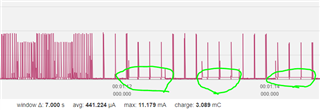I am new to Nrf52832.......I have started development of a custom board based on Bt832 and BT832X.
I have built 2 proto boards one with BT832F and the other with BT832X except that the HW is identical.
I have I prepared a code using AdafruitGLX Nfr Arduino libraries .This code is basically a BLE uart server , with a certain command will activate some Gpio port.
The code works without any problem on Bt832X and give an acceptable power drain of
1mA during advertising and
100uA during main loop.
Now I have tried the BT832 and I have discovered that same code works only if I add an external 32kHz oscillator.This is because the low freq. 9scillator is only present on Bt832X! It should not be possible to run the code on the RC oscillator? I haven't be able to do it!
But after having added a 32768 Cristal and 2 12pF capacitors I have run the same code on BT832F .......but with following power drain figures
7mA during advertising
3mA during loop if not connected
6mA during loop if connected.
I would like to understand what is going on!! Can anybody tell me?






